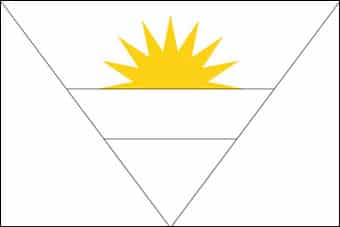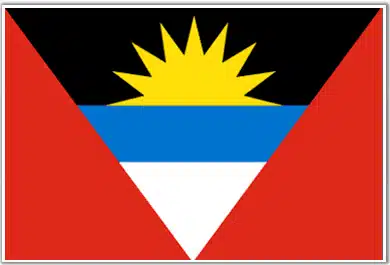
About Flag of Antigua and Barbuda
The Antigua and Barbuda national flag, created by Sir Reginald Samuel, a high school art instructor, was approved on February 27, 1967.
An inverted isosceles triangle may be seen on the Antigua and Barbuda’s top edge. There are three horizontal bars that are white, blue, and black, respectively. A 16-pointed yellow star/sun sign appears at the base of the dark region. A new age is symbolised by the sun in the flag.
The flag’s colours signify several things. Red denotes the vitality of the populace, blue signifies optimism, and black denotes African descent. The V represents success.
Historical Background
The current design of the Antigua and Barbuda flag was adopted on February 27, 1967, when the country gained independence from British colonial rule. The flag’s design has evolved over time to reflect the changing political landscape and aspirations of the nation.
| Official Name: | Antigua and Barbuda |
| Proportion: | 2:3 |
| Adopted on: | February 27, 1967 |
| Designed by: | Reginald Samuels |
| Location of Antigua and barbuda: | Between the Caribbean Sea and the Atlantic Ocean |
| Capital City of Antigua and Barbuda: | St. John |
| Major Cities of Antigua and Barbuda: | English Harbour, Codrington, and others |
| Area: | 170 square miles |
| Population: | 99,660 |
| Currency: | East Caribbean dollar (XCD) |
| Official Language: | English |
| National Anthem: | Fair Antigua, We Salute Thee |
| National symbol(s): | Fallow deer |
| National colors: | red, white, blue, black, yellow |
| National anthem: | |
| Name: | “Fair Antigua, We Salute Thee” |
| Lyrics/music: | Novelle Hamilton RICHARDS/Walter Garnet Picart CHAMBERS |
Design and Colors
The Antigua and Barbuda flag consists of a red base with a horizontal black band across the top and a horizontal blue band across the bottom. In the center of the flag, there is a rising sun motif, depicted in yellow and black. The rising sun symbolizes a new era of independence, hope, and prosperity for the nation.
Symbolism of the Antigua and Barbuda Flag
The colors and symbols on the Antigua and Barbuda flag hold significant meaning. The red color represents the energy, determination, and resilience of the Antiguan and Barbudan people. The black symbolizes the African heritage and unity of the nation. The blue represents the Caribbean Sea surrounding the islands and the maritime history of Antigua and Barbuda. The rising sun signifies a new beginning, progress, and the bright future of the nation.
Usage and Protocol
The Antigua and Barbuda flag is proudly displayed throughout the country on government buildings, educational institutions, and private residences. It is also raised during national holidays, official ceremonies, sporting events, and other significant occasions to express national pride and unity. The flag should be treated with respect and dignity, and it is customary to raise and lower it ceremoniously.
Independence Day Celebrations
Independence Day in Antigua and Barbuda is celebrated on November 1st each year. The day is marked with a range of festivities, including parades, cultural events, music, dance, and fireworks. The flag is prominently displayed and serves as a focal point during these celebrations, symbolizing the nation’s independence and achievements.
FAQs
Q1: When was the current design of the Antigua and Barbuda flag adopted?
The current design of the Antigua and Barbuda flag was adopted on February 27, 1967.
Q2: What do the colors on the flag represent?
The red color represents the energy and determination of the people, the black symbolizes the African heritage and unity, and the blue represents the Caribbean Sea and maritime history.
Q3: What does the rising sun symbolize on the flag?
The rising sun symbolizes a new era of independence, hope, and prosperity for Antigua and Barbuda.
Q4: When is Independence Day celebrated in Antigua and Barbuda?
Independence Day in Antigua and Barbuda is celebrated on November 1st each year.
Q5: What is the significance of Independence Day celebrations?
Independence Day celebrations in Antigua and Barbuda commemorate the nation’s independence from British colonial rule and showcase the achievements, culture, and unity of the Antiguan and Barbudan people.

